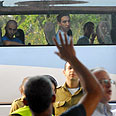
IDF recruits. August 2007
Photo: Yaron Brener
As if draft-dodging wasn't already taking a considerable bite out of the IDF's ranks, it now appears that this year's draft may encounter the smallest age group set for military service in 20 years.
Losing My Religion
Kobi Nahshoni
Right-wing weekly reports army no longer accepting of girls' claims they are religious, even when backed by rabbinate statements. MK Ariel: Religious community won't put up with this; in any case, women's enlistment harmful to society
Sources in the IDF’s Department of Planning and Manpower Administration estimate that the shortage will be felt primarily in the rear corps and logistic support units. In order to prepare for the possible deficit, the IDF will begin stationing more female soldiers in combat-support positions, freeing more male soldiers for combat units.
The army has voiced its disappointment in the low representation of women in combat units, even though those opened their doors to women almost a decade ago. Only 2% of women volunteer to be combat fighters.
And where do the new recruits wish to serve? Topping the list is the Golani Brigade; where three recruits compete for each opening. The brigade boasts an increase from August 2007, when only two were competing for each position in hopes of scoring the iconic brown beret.
The recruitment data for August 2008 obtained by Yedioth Ahronoth shows a 0.6% increase in the motivation of recruits to serve in combat positions, with 67.9% of this year's summer draft choosing to serve in combat units compared to 67.3% in August of last year. The highest motivation level of the past two years was registered in March 2008, when more than 70% volunteered for combat service.
In order to stem the decline in the number of recruits, the military plans to boost its monitoring of youths seeking exemptions from service both before their enlistment, and after it. The past year has shown that stepping up the supervision on exemptions has yielded positive results.
The main challenge the army faces are the exemptions given to those who declare themselves religious but in actuality are not, a trend which is only expected to increase in the coming years.















